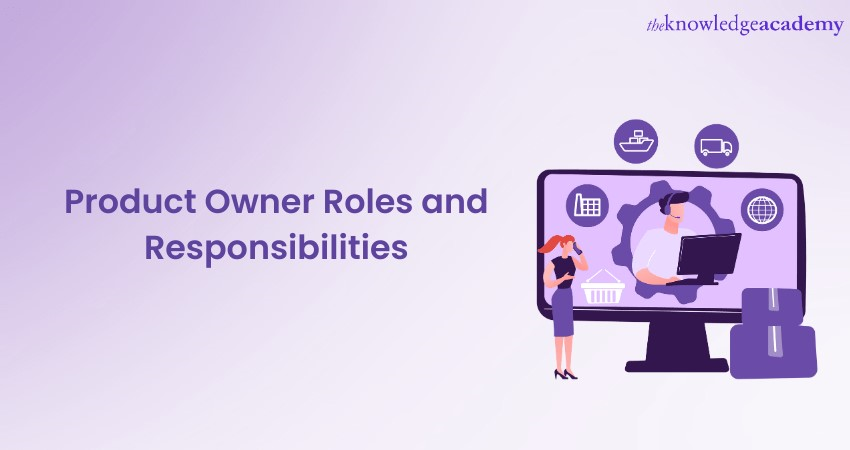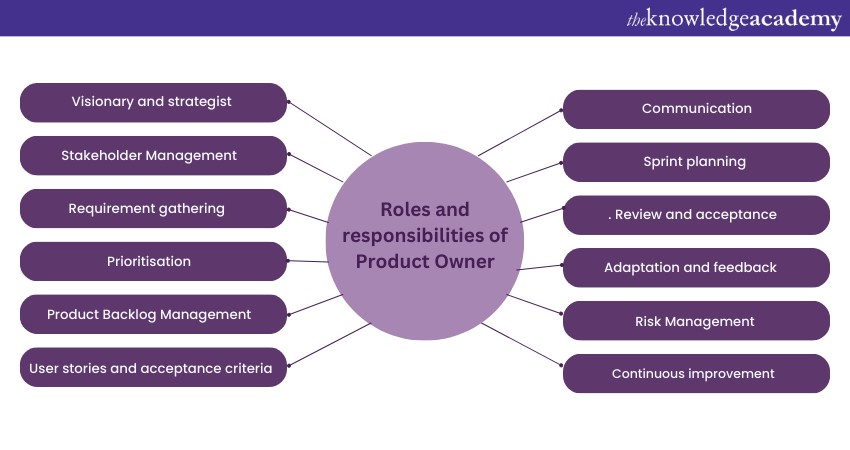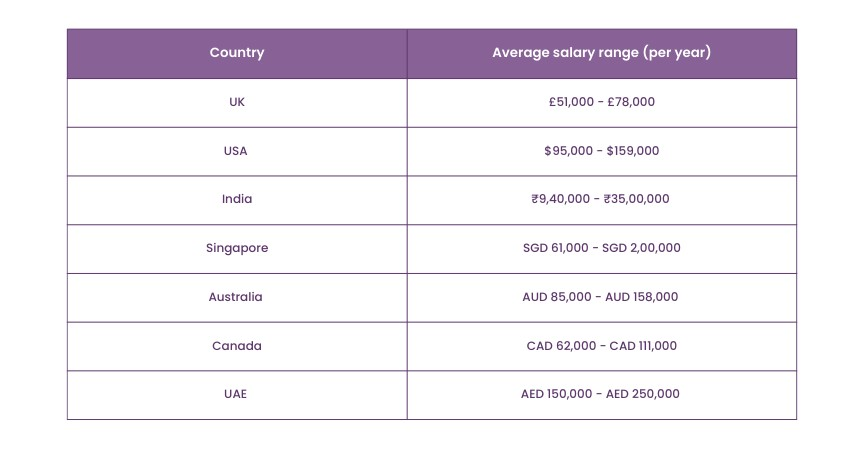We may not have the course you’re looking for. If you enquire or give us a call on 01344203999 and speak to our training experts, we may still be able to help with your training requirements.
Training Outcomes Within Your Budget!
We ensure quality, budget-alignment, and timely delivery by our expert instructors.

In Project Management, the Scrum framework has emerged as a backbone of Agility and collaboration. At the heart of this framework is the Scrum Product Owner (PO), who plays an important role and is responsible for driving product success. Thus, it’s crucial to understand that Product Owner Roles and Responsibilities are crucial in Agile Project Management.
According to Glassdoor, the average salary for a Product Owner is £60,532 per year in the United Kingdom. Such a high pay clearly reflects the importance of the role of a Scrum PO. So, if you are an aspiring Scrum PO willing to land in a big MNC, then you must learn about their Roles and Responsibilities.
So, what are you waiting for? Read this blog to delve into the dynamic world of Product Owner Roles and Responsibilities. Also, explore the crucial role that drives successful Product Development.
Table of Content
1) Who is a Product Owner?
2) Roles and Responsibilities of Product Owner
3) Salary of Product Owner
4) Conclusion
Who is a Product Owner?
A Product Owner (PO) is a crucial professional in a project or Product Development team. A PO plays a vital role in Agile Project Management, particularly in the Scrum framework. Their primary responsibility is to act as the advocate for the end-users or customers and ensure that the project or product meets their needs and expectations.
The Product Owner is a bridge between the people who want the project or product (like customers or stakeholders) and the team that's working on it. Their main job is to understand what needs to be done, why it's important, and how it should work.
Think of the Product Owner as the person who listens to what others want, decides what's most important and guides the team in building it. They work closely with the team, answering questions and providing direction. If the team encounters problems or needs help, the Product Owner is there to support them.
The Product Owner's role is all about keeping everyone on the same page and making sure that the project or product is heading in the right direction. They may need to adjust the plan if new information comes in or if they learn something new along the way.
Roles and Responsibilities of Product Owner

The Role of a Product Owner (PO) in Agile Methodologies, particularly in the Scrum framework, is a multifaceted and critical one. Here's a detailed look at the roles and responsibilities of a Product Owner:
1) Visionary and strategist
One of the crucial Product Owner Roles and Responsibilities is to set the overall vision for the product. They understand the business goals and have a clear strategic direction for the project. They also align the product's development with the organisation's objectives and long-term plans.
2) Stakeholder Management
The PO acts as a person of contact between the development team and stakeholders, including customers, end-users, and other interested parties. They gather input, feedback, and requirements from various stakeholders. Thus, they balance competing interests and ensure their needs are considered.
3) Requirement gathering
The Product Owner is responsible for understanding and documenting the project's requirements. This involves conducting interviews, surveys, and research to ensure a comprehensive understanding of what the users need and want. They also have a clear understanding of the market and industry to make informed decisions.
4) Prioritisation
A crucial aspect of the PO's Role is prioritising the items in the Product Backlog. They decide what features, improvements, or fixes should be worked on first, considering business value, user needs, and dependencies. Effective prioritisation is essential for maximising the Return On Investment (ROI).
5) Product Backlog Management
The PO manages and maintains the Product Backlog, which is the prioritised list of work items for the project. They continually refine and update the backlog based on changing requirements, new insights, and feedback from stakeholders.
6) User Stories and acceptance criteria
The PO writes User Stories, which are brief descriptions of product features or functionality from a user's perspective. These Stories provide context and detail for the development team. They also define acceptance criteria, which are specific conditions required for a user story to be complete.
7) Communication
The Product Owner is a central figure in communication within the project. They ensure that all stakeholders are informed about the project's progress. They work closely with the development team, answering questions, providing clarifications, and making decisions during development.
8) Sprint planning
In Scrum, work is organised into time-boxed development cycles called Sprints. The PO participates actively in Sprint planning meetings. They discuss the prioritised items from the Product Backlog with the team and collaboratively plan what can be achieved during the Sprint.
9) Review and acceptance
At the end of each Sprint, the development team presents their completed work to the PO. It's the PO's Responsibility to review the work and decide if it meets the acceptance criteria and fulfils the user requirements. They accept or reject the work, and any rejected work items are put back into the product backlog for future Sprints.
10) Adaptation and feedback
The Product Owner is flexible and adaptable. As the project progresses, they may receive feedback from users and stakeholders or from analysing the project's performance. The PO ensures that this feedback is incorporated into the project, which may involve reprioritising and adjusting the product backlog.
11) Risk Management
Identifying and mitigating risks related to the project is a part of the PO's responsibilities. This includes identifying potential obstacles and finding ways to address or circumvent them.
12) Continuous improvement
A good Product Owner always strives for improvement. They reflect on the project's progress, gather feedback, and use this information to enhance the product and the development process.
Transform your career and become a certified Product Owner – join our Certified SAFe® Product Manager / Product Owner Training And Exam now!
Salary of Product Owner
The salary of a Product Owner can vary depending on several factors. On average, in the United Kingdom, a Product Owner's annual salary typically falls within the range of £51,000 to £78,000, with variations based on experience, location, industry, and organisation size. Here’s a table showcasing the average salary of a PO across countries:

Source: Glassdoor
In recent years, the demand for Product Owners has been on the rise as businesses increasingly adopt Agile methodologies to stay competitive. This growing demand, coupled with the critical Product Owner Roles and Responsibilities, suggests that salaries for this role are likely to remain competitive and potentially increase in the future
Unlock your potential with Agile Training and take your Agile career to the next level!
Conclusion
Understanding the Product Owner Roles and Responsibilities is pivotal to the success of any product development process. Their multifaceted responsibilities, from defining the product vision to prioritising features and ensuring alignment with customer needs, underscore their importance. A skilled Product Owner can steer a project towards its goals and deliver a product that truly resonates with its users.
Unlock your potential as a Scrum Product Owner – join our Scrum Product Owner Training today!
Frequently Asked Questions
Upcoming Project Management Resources Batches & Dates
Date
 Scrum Master Certification
Scrum Master Certification
Thu 2nd May 2024
Thu 9th May 2024
Thu 23rd May 2024
Thu 30th May 2024
Thu 6th Jun 2024
Thu 13th Jun 2024
Thu 20th Jun 2024
Thu 27th Jun 2024
Thu 4th Jul 2024
Thu 18th Jul 2024
Thu 25th Jul 2024
Thu 1st Aug 2024
Thu 8th Aug 2024
Thu 15th Aug 2024
Thu 29th Aug 2024
Thu 5th Sep 2024
Thu 19th Sep 2024
Thu 26th Sep 2024
Thu 3rd Oct 2024
Thu 10th Oct 2024
Thu 17th Oct 2024
Thu 24th Oct 2024
Thu 31st Oct 2024
Thu 7th Nov 2024
Thu 21st Nov 2024
Thu 5th Dec 2024
Thu 19th Dec 2024







 Top Rated Course
Top Rated Course



 If you wish to make any changes to your course, please
If you wish to make any changes to your course, please


